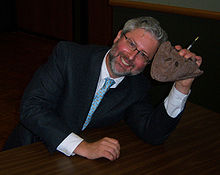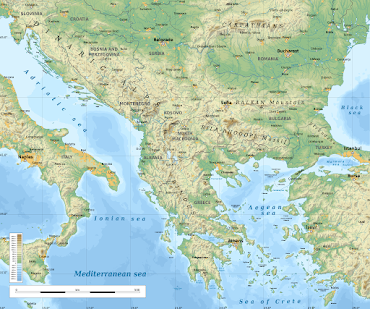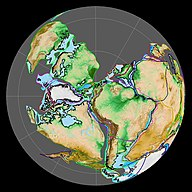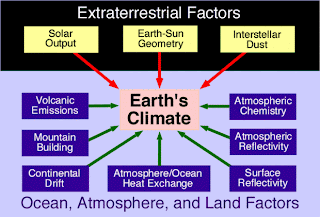Followers
Thursday, December 14, 2023
Medical Breakthroughs in 2023
Monday, December 11, 2023
The Vinča Culture
The Vinča culture is named for the Serbian site southeast of Belgrade, the capital of Serbia. The site was initially excavated by the Lithuanian archaeologist Marija Gimbutas.
The oldest scribed symbols found in Central Europe have been found on Neolithic artifacts (7th to 5th millennia BC) of the Vinča culture. Scholars believe that the Vinča signs represent the earliest form of writing, predating ancient Egyptian and Sumerian writing by thousands of years.
Here are some of the Vinča signs:
Wednesday, December 6, 2023
Trilobites Found in Ash Layers
Abstract:
Friday, December 1, 2023
The Fish That Landed
Tiktaalik roseae is a 375-million-year fossil fish that was discovered in the Canadian Arctic in 2004. Its discovery is believed to shed light on a point in evolutionary history when the very first fish ventured out onto land. It is sometimes referred to as a "fishapod".
Tiktaalik roseae is a genus of extinct lobe-finned fish from the late Devonian period, when the earliest forests appeared along with land animals such as arthropods (myriapods, arachnids and hexapods). Tiktaalik had some features like those of four-legged animals. It is an example of an ancient sarcopterygian fish which adapted to a swampy oxygen-poor water habitat. The creature is regarded by evolutionists as a transition from fish to tetrapod.
What I find exciting about this discovery is the critical method and logistics of the exploration over four summers in the Alaskan Arctic. Tiktaalik was discovered through a well-conceived methodically launched project to find a predicted specimen and demonstrates the predictive capacity of paleontology.
The Nunavut field project had the express aim of finding an intermediate between Panderichthys and tetrapods, by searching in sediments from the most probable environment (rivers) and time (early Late Devonian). Second, Tiktaalik adds enormously to our understanding of the fish-tetrapod transition because of its position on the tree and the combination of characters it displays.
I especially like Crowther’s last sentence which I present in its original form (bold type included): “There’s a problem with the Darwinist position that runs even deeper than this, however: If Darwinian evolution is an undisputed fact, as its chief defenders routinely claim, why is this fossil find being billed as such an crucial piece of evidence?”
Icing on the cake! I love it!!!
What I love even more is all this rhetoric and absolutely no reference to the actual fossil material. So, I'll take that as meaning that these guys have nothing to say about its transitional status. The real icing on the cake is all this puff and no real substance.
Unfortunately, the media's response to the discovery is not quite the same as the palaeontological community's interpretation of it. Therefore, by responding to these articles, creationists and their ilk are just blowing smoke. The importance of Tiktaalik has nothing to do with proving the fish-tetrapod transition. That's pretty much taken care of by a wealth of data from the past 100 years."
One wonders why Brazeau even cares what creationists think. Does he harbor a certain fear that maybe the scheme he presents could point to a Creator?
Thursday, October 26, 2023
Women in the American Scientific Affiliation
Janel M. Curry, Executive Director of the American Scientific Affiliation (ASA)
Dorothy F. Chappel
Saturday, October 21, 2023
The Genesis Rulers Through the Lens of Anthropology
Dr. Tim Daughtry, a Christian Apologist, reviews The First Lords of the Earth: An Anthropological Study
The book of Genesis is typically read and interpreted by Christians and Jews in one of two ways. In one approach, Genesis is treated as a literal and accurate description of human origins and early human history. In this literalist view, Adam and Eve were not only real people, but they were also the first people on Earth. In the other approach, Genesis is read as a series of folk stories and myths that reveal important truths about humanity when interpreted allegorically. In this view, Adam and Even are characters in the creation story rather than real people who existed in history. The important point in this mode of interpretation is not that Adam and Eve were real historical characters but that that the story reveals important truths about human pride, disobedience, estrangement from God, and the hope of reconciliation.
In The First Lords of the Earth, Alice Linsley offers a fresh perspective through the lens of Biblical anthropology. Drawing from over forty years of research into Genesis along with scientific studies of ancient cultures, symbols, beliefs, and linguistic analysis, Linsley makes the case that the important figures of Genesis were not only real people but were members of the early Hebrew caste of ruler-priests who moved from Africa into the Fertile Crescent and Ancient Near East. As just one example, she makes the case that the Adam and Eve of Genesis were not the first humans, but neither were they mythical archetypes. Instead, Adam was a real ruler who lived in a vast area around the Nile River and whose sons Cain and Seth married the daughters of Enoch, who lived at the same time. The book’s exploration of early Hebrew kinship, marriage, and ascendancy patterns places these and later Biblical characters in an evidence-based historical context and provides rich anthropological context for the Scriptural accounts of the lives of later figures such as Abraham, Noah, and Joseph. The title of the book derives from the anthropological evidence that these and other early figures in Scripture were powerful ruler-priests with extensive domains in the lands described in the Bible.
The book offers a detailed look at a number of factors of early Hebrew culture, but one of the most interesting was the evidence that belief in God Father and God Son, along with a Messianic hope, was an important theme in Hebrew thought going back 6000 years that foreshadowed the beliefs of Christianity. Linsley makes a powerful case that the foundations of Christianity were present in early Horite and Sethite Hebrew beliefs that were present long before Abraham’s time.
The First Lords of the Earth is an excellent resource for a wide range of readers, including those interested in early Hebrew history for its own sake and for those who want to deepen their understanding of Scripture.
END
Related Reading: The First Lords and Their Authority; The First Lords and Messianic Expectation; The Adam and Eve of History
Tuesday, October 3, 2023
The 2023 Nobel Prize Awards
Friday, September 22, 2023
Huge Spider Fossil Found in Australia
Photo credit © Michael Frese
The spider is named "Megamonodontium mccluskyi", a reference to its nearest living relatives, a group of tiny brush-footed trapdoor spiders from the genus Monodontium. The latter name is after Dr Simon McClusky who discovered the fossil in June 2020.
Read more here: Astonishing 15-Million-Year-Old Spider Fossil is the Second Largest Ever Found
Thursday, September 14, 2023
Tips for STEM Teachers
If you are teaching STEM-related courses, congratulations because you are trailblazing a generation of engineers and technology experts. This is an opportunity to be at the forefront of something that could potentially shake up the job market in the years to come.
If you are looking for encouragement and advice, here are some tips that should help anyone who teaches a STEM-related course.
1. Integrate All Four STEM Subjects
As stated earlier, STEM combines four subjects: Science, Technology, Engineering, and Mathematics. As a STEM teacher, you should familiarize yourself with all these subjects and be ready to integrate them into your teaching methods. As a result, the students will get real-world, meaningful learning.
As a STEM educator, you help your students apply what they learn to real-life situations. You can do that by setting up practical lessons where their knowledge is tested, and they have to use what they have learned to solve real-life problems.
This should help them develop thinking, investigative, reasoning, and creative skills that should come in handy in this modern and technology-oriented world.
2. Have a Good STEM Curriculum
It can be relatively hard to find a STEM curriculum that has been set out by the relevant educational authorities, particularly because it doesn’t exist. However, several sites have put up agood and reliable STEM lesson guides.
One of the most popular and highly recommended ones is eFGI for Teachers. Here, you will find a variety of tools to boost your students’ math and science skills, as well as ideas on how to enliven the classroom with engineering projects.
They have lesson plans, class activities, outreach programs, and also web resources, among a host of other things that could guide you to make your STEM lessons as interactive and educative as possible.
Another site that offers good and reliable lesson guides is TeachEngineering. However, you must be cautious in the STEM teaching guides you use because not every guide that claims to be a STEM guide is actually a STEM guide.
Here are a few things you can use to determine if the guide is suited for STEM lessons.
A good STEM lesson is guided by the seven-step engineering design process in solving problems:
Focuses on real-world problems.
Provides for multiple right answers and reiterates the importance of failure as a part of learning.
Involves students in productive teamwork.
Applies rigorous math and science content.
Immerses students in hands-on inquiry and open-ended exploration.
Supports a teaching process that is mainly student-centered and inquiry-based.
Requires students to tap into their design skills and create a prototype of the solutions.
Using this checklist, you can now know which online teaching curriculum is good enough for you to use and can include in your STEM teacher preparation.
Thursday, August 24, 2023
Thursday, July 20, 2023
First Lords is a Paradigm-Shifting Book
It has been a long time coming, but my book The First Lords of the Earth: An Anthropological Study is now available to purchase on Amazon. Options include Kindle, paperback, and hard cover, and all are priced to accommodate the book lover on a tight budget.
This book identifies the social structure and religious beliefs of the early Hebrew ruler-priest caste (6000-4000 years ago), their dispersion out of Africa, their territorial expansion, trade routes, and influence on the populations of the Fertile Crescent and Ancient Near East. It includes diagrams showing the kinship pattern of the biblical Hebrew.
There are many examples: the distinct duties/responsibilities of the mother's house versus the father's house; male prophets-female prophets; male rulers-female rulers; inheritance by male heirs-inheritance by female heirs, patrilocal residence-matrilocal residence; Hebrew patronymics-Hebrew matronymics; and in the Hebrew double unilineal descent pattern, both the patrilineage and the matrilineage are recognized and honored, but in different ways.
There is binary balance in the New Testament narratives also. Jesus restored the widow of Nain's deceased son to his mother (Luke 7:11-17). Jesus restored Jairus' deceased daughter to her father (Mark 5:21-43).
When Jesus was presented in the temple His identity as Messiah was attested by the priest Simeon and the prophetess Anna.
To understand the gender distinctions and binary balance of the early Hebrew, we must dismiss the false narrative that their social structure was patriarchal.
The research took 40 years, but I was able to make a rather complex subject easy to understand. I hope you will buy the book and discover answers to some perennial questions, such as:
- Who were the Horite Hebrew and the Sethite Hebrew?
- Where is the oldest known site of Horite Hebrew worship?
- Why did so many Hebrew men have two wives?
- What was the difference in status between wives and concubines?
- What types of authority did the biblical Hebrew recognize?
- What were some symbols of authority among the early Hebrew?
- How did their acute observation of the patterns in Nature inform their reasoning?
- If Judaism is NOT the Faith of the early Hebrew, what did they believe?
Alice C. Linsley
Wednesday, June 14, 2023
Donkeys Descend from Wild East African Asses
Donkeys were first domesticated from wild asses around 7,000 years ago in East Africa, perhaps helping humans adapt to more arid conditions (Credit: Eric Lafforgue/Getty Images)
"While rivers such as the Euphrates and Tigris in Mesopotamia and the Nile in Egypt could be used for transport of heavy and/or bulk goods, donkeys meant a massive increase and intensification of contacts over land," she says.
Saturday, June 10, 2023
Sound Used to Improve Reef Complexity
A speaker is installed on the seafloor to play the sounds of a healthy reef ecosystem in the hopes of encouraging coral larvae settlement. (Photo by Dan Mele, © Woods Hole Oceanographic Institution)
Aran Mooney has found that by recording the sounds of a healthy reef and playing them back to coral larvae, the larvae may settle where they normally wouldn’t—on a damaged reef in need of restoration.
Larvae placed in acoustically transparent cups and isolated from all other environmental cues were more likely to settle onto the reef and grow when the cups were placed on a vibrant, noisy reef than on a degraded one lacking a complex soundscape.
Although that seems like bad news for damaged reefs, coral larvae’s attraction to healthy reef sounds could prove to be a powerful tool in reef restoration efforts.
Wednesday, May 24, 2023
Our Amazing Sun
Did you know that "The sun lies at the heart of the solar system, where it is by far the largest object. It holds 99.8% of the solar system's mass and is roughly 109 times the diameter of the Earth — about one million Earths could fit inside the sun.
The surface of the sun is about 10,000 degrees Fahrenheit (5,500 degrees Celsius) hot, while temperatures in the core reach more than 27 million F (15 million C), driven by nuclear reactions. One would need to explode 100 billion tons of dynamite every second to match the energy produced by the sun, according to NASA.
The sun is one of more than 100 billion stars in the Milky Way. It orbits some 25,000 light-years from the galactic core, completing a revolution once every 250 million years or so. The sun is relatively young, part of a generation of stars known as Population I, which are relatively rich in elements heavier than helium. An older generation of stars is called Population II, and an earlier generation of Population III may have existed, although no members of this generation are known yet.
Friday, May 19, 2023
Dinosaurs on Noah's Ark?
You are invited to attend "Writing as a Christian Woman in Science: personal experience from Baby Dinosaurs on the Ark with Janet Kellogg Ray." We will be listening to Janet talk about her recent book, Baby Dinosaurs on the Ark?: The Bible and Modern Science and the Trouble of Making It All Fit. She will share her personal story as a Christian Woman in Science and discuss the book publishing process as a professional writer in science and faith. This will be an enlightening time for those interested in the science and faith dialogue, as well as those interested in publishing their own work one day.
Janet is the author of Baby Dinosaurs on the Ark? The Bible and Modern Science, and the Trouble of Making It All Fit, A Study Guide for Baby Dinosaurs on the Ark, and releasing in October, The God of Monkey Science: People of Faith in a Modern Scientific World.
Join Zoom Meeting on May 21 or 23:
https://us02web.zoom.us/j/85174704294
A Study Guide for BABY DINOSAURS ON THE ARK?: https://amzn.to/3mLJ9Fu
Check out this book review by CWiS member, Kristine Johnson.
Friday, April 28, 2023
Male Sea Lions Rebounding
California sea lions have managed to maintain -- and, in the case of males, increase -- their average body size as their population grows and competition for food becomes fiercer. This is in contrast to other marine mammals, whose average body size tends to decrease as their numbers increase. Researchers report that sexual selection was a strong driving force for males to grow bigger and to strengthen muscles in their neck and jaw that help them fight for mates. Both male and female sea lions evaded food shortages by diversifying their diets and, in some cases, foraging further from the shore.
Friday, March 31, 2023
Women Excel in STEM
From Presidents and CEOs of organizations, to researchers, science writers, and journalists, Christian women in STEM are leaders in their fields and paving the way for others to follow. As Women’s History Month draws to a close, we highlight the work of ten Christian women in various STEM fields, including astrophysics, engineering, biology, and climate science. We also include science communicators who are doing the important work of sharing science with lay Christian audiences through writing and journalism. Of course this is not an all inclusive list of Christian women in STEM. There are countless others throughout history who have pioneered and unlocked discoveries in their fields. And there are many more contemporary Christian women in STEM fields like Mary Schweitzer who found the first evidence of soft tissue in a 68-million year dinosaur bone, Carol Hill whose research gave us a better understanding of the age and origin of the Grand Canyon, and Katherine Johnson, a NASA mathematician whose work helped send Apollo to the Moon.
Christian women are also leading important conversations on the intersection of faith and science, which has traditionally been dominated by white male voices. Faith and science organizations like the American Scientific Affiliation (ASA) was previously led by rocket scientist Leslie Wickman, the Dialogue on Science, Ethics and Society (DoSER) program has been led by astrophysicist Jennifer Wiseman, and BioLogos is currently led by astronomer Deb Haarsma. Christian sociologist Elaine Howard Ecklund has dedicated her career to understanding how scientists and religious people perceive each other, helping combat misconceptions and bridge the communication gap between faith and science communities on important topics like Climate Change, COVID-19, and evolution.
Despite numerous role-models, Christian women still remain underrepresented in STEM, and the numbers are even starker for Christian women of color. Being a woman in STEM comes with its own set of challenges, but there are also challenges that are unique to Christian women. In an interview with BioLogos, Loryn Phillips, a graduate student in biology and member of the Christian Women in Science (CWiS) leadership board shared: “On top of the challenges that already come with being a woman in science, Christian women in science carry additional burdens. We don’t want to lose the respect of our colleagues or jeopardize our careers because we identify as Christian, especially when we desire to be public and vocal about sharing God’s majesty in our work with others.” Sadly even in the Church, Loryn shared that Christian women in science face the challenge of, “feeling ashamed or not feeling safe to discuss their research for fear of ridicule or judgment, and feeling alone.” There is still work to be done, but thankfully there isn’t a shortage of Christian women role-models in STEM for the next generation of women and girls to look up to and see themselves represented.
Read more here: 10 Christian Women to Know: STEM Edition - Post - BioLogos; Sister Mary Celine Fasenmyer; Sister Mary Gervase; Agnes Giberne: A Lover of Science; Christian Women in Science, Technology and Engineering
Monday, February 13, 2023
Pangaea, Rodinia, Columbia, and Kenorland
Rodinia (Russian родина, meaning "motherland" or "birthplace") was a Neoproterozoic supercontinent that assembled 1.1–0.9 billion years ago and broke up 750–633 million years ago. Rodinia's continental fragments reassembled to form Pannotia 633–573 million years ago (shown below).
Another of Earth's supercontinents is called Columbia (Nuna or Hudsonland) and is thought to have existed approximately 2,500 to 1,500 million years ago in the Paleoproterozoic Era (from 2,500 to 1,600 million years ago). Zhao et al. 2002 proposed that the assembly of the supercontinent Columbia was completed by global-scale collisional events during 2.1–1.8 billion years ago. Other sources give 1,820–1,350 million years ago.
Columbia consisted of proto cratons that made up the cores of the continents of Laurentia, Baltica, Ukrainian Shield, Amazonian Shield, Australia, and possibly Siberia, North China, and Kalaharia as well.
Tuesday, February 7, 2023
2023 "Year of Open Science"
NASA has declared 2023 as the Year of Open Science to celebrate the benefits and successes of open science and to inspire more scientists to adopt open science practices. NASA's Year of Open Science is part of the five-year Transform to Open Science (TOPS) mission and the Open Source Science Initiative (OSSI). TOPS is an ambitious plan to accelerate open science practices and major scientific discoveries by increasing understanding and adoption of open science practices and broadening participation by historically excluded communities.
Strategic Objectives
Open Science creates more advanced and inclusive research faster, builds a more just and equitable world, and ensures that minds from all walks of life can participate in science. TOPS is NASA’s ambitious plan to accelerate open science practices. It’s a 5-year journey that will:
Broaden participation by historically excluded communities.
Increase understanding and adoption of open science principles and techniques.
Open Science will broaden participation, increase accessibility to knowledge, and embrace new technologies that can respond to these changes at scale.
More information: https://science.nasa.gov/open-science/transform-to-open-science
Monday, January 30, 2023
Dr. Judith Curry Deserves a Fair Hearing
The climate models used by scientists working for the United Nations cannot explain why the climate suddenly cooled between 1950 and 1970, giving rise to widespread warnings about the onset of a new ice age.
Curry notes that between 1910 and 1940, the planet warmed during a climatic episode that resembles our own, down to the degree. The warming cannot be blamed on CO2 emissions because the carbon-dioxide emissions from burning fossil fuels were relatively small in those years. Curry says, “almost half of the warming observed in the twentieth century came about in the first half of the century, before carbon-dioxide emissions became large.”
Speaking of climate changes, she points to natural factors, of which there are many. These factors reveal far greater complexity than is generally acknowledged by global warming alarmists.
However, among the scientists in these organizations there is a range of positions as to which factors contribute most to warming. All tend to agree that solar radiance and Earth-Sun geometry are very significant. Yet we hear about this less than we hear about the danger of CO2 emissions from fossil fuel energy sources.
Earth's climate varies from region to region and from age to age. Therefore, it is misleading to speak of "climate change". Instead, we should speak of "climate changes" over vast periods of time. The Pleistocene glacial epoch (2,600,000-11,700 years ago) saw substantial variations in the extent of glaciers and ice sheets. These variations were driven by changes in the distribution of solar radiation across Earth’s surface. The insolation pattern is strongly affected by the geometry of Earth’s orbit around the Sun and by the orientation, or tilt, of Earth’s axis relative to the direct rays of the Sun.
Researchers identified two distinct environments at the South Pole at the close of the Permian Period. There was a warm rainforest with tree-ferns, palm trees, and baobab trees at the lower elevations, and a cooler mountainous region dominated by beech trees and conifers.
In the cycle of Earth’s Great Year, the line off the North Pole axis (extending toward Polaris) scribes a complete circle in the heavens about every 25,800 years. A complete cycle takes between 25,000 and 28,000 years, depending on the amount of Earth's wobble. One cycle is Earth’s Great Year. Climate and atmospheric changes appear to become more acute toward the end and beginning of a new year.
Monday, January 16, 2023
Self-Healing Concrete
Cement-matrix composites include concrete (containing coarse and fine aggregates), mortar (containing fine aggregate, but no coarse aggregate), and cement paste (containing no aggregate, whether coarse or fine).
The ancient Romans built extremely durable sea walls using a concrete made from lime and volcanic ash to bind with rocks. Rather than eroding in the presence of sea water, the material gained strength from the exposure. Scientists have discovered that elements within the volcanic material reacted with sea water to strengthen the construction.
“Contrary to the principles of modern cement-based concrete, the Romans created a rock-like concrete that thrives in open chemical exchange with seawater,” reports Marie Jackson (University of Utah) in the journal American Mineralogist.
Related reading: Ancient Roman Concrete was Incredibly Strong
Tuesday, January 3, 2023
Massive Fish Nest Colony




























